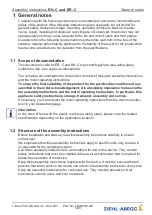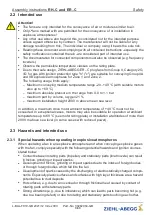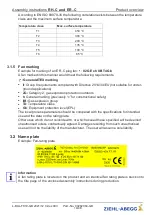
2.2 Intended use
Attention!
•
The fans are only intended for the conveyance of air or mixtures similar to air.
•
Only
fans marked with are permitted for the conveyance of or installation in
explosive atmospheres!
•
Any other use above and beyond this is considered not for the intended purpose
unless agreed otherwise by contract. The manufacturer will not be liable for any
damage resulting from this. The individual or company using it bears the sole risk.
•
Reading these document and complying with all contained instructions -especially the
safety noti
fi
cations contained therein -are considered part of intended use.
•
The documentation for connected components must also be observed (e.g. frequency
inverters).
•
Observe the permissible temperature classes on the rating plate.
•
Due to their safe design, ZIEHL-ABEGG ER...C plug fans from Group II, Category 2G,
3G for gas with ignition protection type "h" ("c") are suitable for conveying Group IIA
and IIB explosive atmospheres for Zone 1 and Zone 2.
The following usage limits apply:
–
Maximum conveying medium temperature range -20...+40
°
C (with suitable motors
also up to +60
°
C)
–
maximum absolute pressure in the range from 0.8 to 1.1 bar
–
maximum part by volume, oxygen 21 %
–
maximum installation height 2000 m above mean sea level
In addition, a maximum drive motor ambient temperature of +40
°
C must not be
exceeded. In exceptional cases, motors may also be suitable for operation at ambient
temperatures up to 60
°
C (see motor rating plate) or installation at altitudes of more than
2000 m above sea level (in some cases with reduced power).
2.3 Hazards and intended use
2.3.1 Special hazards when operating in explosive atmospheres
When operating a fan in an explosive atmosphere and when conveying explosive gases
with the fan, comply especially with the following potential hazards and ignition sources
stated below:
•
Contact between rotating parts (impeller) and stationary parts (inlet nozzle) can result
in friction, grinding or impact sparks.
•
Development of friction, grinding or impact sparks due to the intake of foreign bodies
or through foreign bodies which fall into the fan.
•
Development of sparks caused by the discharging or electrostatically charged compo-
nents. Especially plastic surfaces and surfaces with high layer thickness are a hazard
potential due to dust deposits.
•
Hot surfaces, e.g. due to an overload or through frictional heat caused by contact of
rotating parts with stationary parts.
•
Strong vibrations (e.g., due to imbalance) which can lead to parts becoming hot (e.g.,
due to a bearing defect) or due to rotating and stationary parts touching each other.
Assembly instructions
RH..C and ER..C
Safety
L-BAL-F019-GB 2021/12 Index 003
Part.-No. 00282064-GB
8/48









































